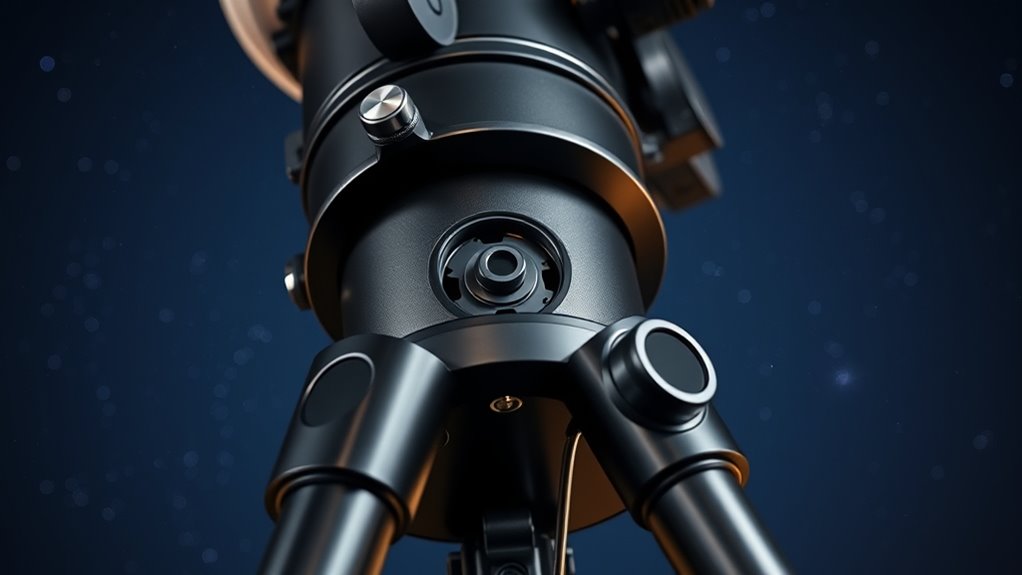For precision astrophotography, I recommend the iEXOS-100-2 PMC-Eight system, which features a belt drive for smooth, quiet tracking. Its high gear precision, reliable load capacity, and wireless connectivity make it a top choice. The system is easy to set up and compatible with multiple devices, ensuring stability during long exposures. If you’re curious about deeper details and what makes it stand out, keep exploring the options available.
Key Takeaways
- High-quality belt drive mounts offer smoother, quieter tracking essential for long-exposure astrophotography.
- Look for models with dual-axis worm gears and precise belt tension for minimal backlash and high accuracy.
- Consider mounts with advanced control features, WiFi/Bluetooth connectivity, and quick setup for enhanced usability.
- Prioritize stability and load capacity to prevent vibrations during long exposures, ensuring optimal imaging results.
- Invest in reputable brands known for durability, engineering quality, and long-term reliability in belt drive equatorial mounts.
iEXOS-100-2 PMC-Eight Astrophotography Tracker System (WiFi & Bluetooth)
If you’re looking for an affordable, portable equatorial tracker that combines advanced technology with user-friendly features, the iEXOS-100-2 PMC-Eight system is an excellent choice. It uses Explore Scientific’s PMC-Eight system, which boasts eight independent CPUs for quick responsiveness and reliable performance. The mount features quiet stepper motor belt drives and clutched dual-axis worm gears, ensuring smooth, precise movements. Setup is quick thanks to a sight hole for polar alignment and adjustable altitude, eliminating the need for a polar scope. Plus, it’s WiFi and Bluetooth compatible, with an intuitive ExploreStars app that simplifies star alignment and celestial navigation.
Best For: amateur astrophotographers seeking a portable, affordable equatorial tracker with advanced technology and user-friendly features.
Pros:
- Combines eight independent CPUs for fast responsiveness and reliable performance
- Quiet stepper motor belt drives and dual-axis worm gears ensure smooth, precise movements
- Quick setup with sight hole for polar alignment and adjustable altitude, eliminating the need for a polar scope
Cons:
- Flimsy tripod legs may affect stability during long exposures
- Occasional WiFi connectivity and firmware update issues can be frustrating
- Lack of azimuth adjustment requires optional accessories for perfect alignment
Factors to Consider When Choosing Equatorial Mounts With Belt Drive Systems

When selecting an equatorial mount with a belt drive system, I consider factors like gear precision and build quality to guarantee accurate tracking. I also check the load capacity to match my equipment and make sure the power setup suits my observing sessions. Additionally, I pay attention to noise levels and compatibility with my devices to guarantee smooth, quiet operation.
Gear Precision and Quality
High-quality belt drive systems are essential for achieving precise and smooth tracking in equatorial mounts, especially during astrophotography. These systems use precision-engineered gears made from durable materials like steel or reinforced composites, which help minimize backlash and guarantee consistent performance. Tighter manufacturing tolerances in the components lead to improved positional accuracy and reduce periodic error, resulting in more reliable tracking. The gear ratio between the motor—whether stepper or servo—and the reduction gear considerably impacts the mount’s responsiveness and precision. Properly designed belt drives also operate quietly and efficiently, allowing for unobtrusive observations. Investing in high-quality gears means your mount will deliver the accuracy needed for astrophotography, making it easier to capture sharp, detailed images with minimal adjustments.
Load Capacity Limits
Choosing the right equatorial mount with a belt drive system depends heavily on understanding its load capacity limits. These limits indicate the maximum weight the mount can support without sacrificing stability or tracking accuracy. Exceeding this capacity can cause vibrations, gear slippage, or motor strain, all of which severely impact astrophotography results. Belt drive systems usually operate smoothly and quietly within their specified load, but overloading accelerates wear on belts and gears, risking damage and reducing lifespan. Manufacturers base recommended load capacities on motor torque and gear strength, so it’s vital to follow these guidelines. Properly matching your equipment’s weight to the mount’s capacity ensures precise tracking, minimizes star trailing, and maintains the longevity of your investment.
Power and Battery Needs
Reliable power sources are essential for belt drive equatorial mounts to maintain smooth, accurate tracking during long imaging sessions. The power requirements depend on the motor size, control electronics, and accessories like guiding cameras or dew heaters. Most mounts operate on 12V DC, but some include built-in batteries or portable packs for convenience. Using an unstable or inadequate power supply can cause tracking errors, motor stalls, or firmware glitches, so stable, regulated power is critical. For extended sessions, external power solutions like Lithium PowerTanks or portable batteries are highly recommended to prevent interruptions and ensure ideal performance. Investing in a reliable, consistent power source helps avoid issues and keeps your astrophotography sessions smooth and productive.
Compatibility With Devices
When selecting an equatorial mount with belt drive systems, ensuring compatibility with your devices is vital for smooth operation and control. You’ll want to confirm that the mount supports your smartphone, tablet, or computer through WiFi, Bluetooth, or serial connections. Compatibility with popular software platforms like ASCOM or INDI is fundamental for seamless integration and device management. Open-source software support is also beneficial, allowing for customization and troubleshooting with third-party guiding or imaging tools. Check that the physical connection options—USB, serial, or wireless—match your device ports and communication protocols. Finally, keep firmware updates in mind; staying current ensures your mount remains synchronized with evolving device drivers and control software, providing reliable and efficient operation during your astrophotography sessions.
Noise and Vibration Levels
Belt drive systems are known for operating more quietly than traditional gear-based mounts because they engage smoothly and generate less mechanical noise. This quieter operation is a significant advantage during long astrophotography sessions, where minimizing disturbances helps maintain focus. Proper belt tension is vital; if too loose, it can cause vibrations and backlash, reducing image stability. Conversely, overly tight belts may increase noise and wear on components. Belt drives also excel at damping vibrations, resulting in steadier images during long exposures. Since they lack metal-on-metal contact, vibrations are transmitted less to the mount, improving overall stability. The quality of the belt material and motor design also influences noise levels—higher-quality systems tend to operate more silently, ensuring a smoother, more peaceful imaging experience.
Ease of Setup
Choosing an equatorial mount with belt drives can make setup faster and easier, especially for beginners. Belt drives offer smoother, quieter operation, which simplifies alignment and reduces the fuss. They also cut down on mechanical backlash, making initial polar alignment quicker and more precise. Many belt drive mounts feature quick polarization methods or built-in sighting aids, speeding up setup even further. The assembly process tends to involve fewer adjustments, saving valuable time before imaging begins. Additionally, some models include WiFi or app controls, allowing remote calibration and alignment—no need for complex manual tweaks. All these factors combine to make setup less intimidating, helping you get your telescope ready faster so you can focus more on capturing stunning astrophotography images.
Price and Value
Opting for an equatorial mount with a belt drive system often means investing more upfront, but the added cost can be justified by its superior tracking accuracy and quieter operation. Belt drives tend to be pricier than gear-based mounts because of their precision components and reduced backlash. When evaluating price and value, consider whether the improved tracking and minimal periodic error outweigh the higher initial expense. Cheaper belt drive mounts may sacrifice build quality or motor power, affecting performance and durability. Conversely, high-quality models offer features like smoother tracking, quieter operation, and better long-term reliability. Comparing costs should also factor in potential savings from improved astrophotography results and lower maintenance needs over time, making the higher investment worthwhile for serious astrophotographers.
Frequently Asked Questions
How Does Belt Drive Improve Tracking Accuracy in Equatorial Mounts?
Belt drive improves tracking accuracy in equatorial mounts by reducing gear backlash and eliminating periodic errors common with traditional gear systems. I’ve found that belts offer smoother, quieter movements, which is essential for long exposures. They also minimize vibrations, helping me keep my astrophotography sharp. Overall, belt drives give me more precise control, making it easier to capture clear, detailed images of the night sky.
Are Belt Drive Systems Suitable for Astrophotography Beginners?
Yes, belt drive systems are great for beginners. They’re quieter, smoother, and reduce backlash, making tracking more precise without needing advanced adjustments. I found that they’re user-friendly and improve overall stability, which is perfect when you’re just starting out. Plus, they often require less maintenance, helping newcomers focus on learning the basics of astrophotography without getting overwhelmed by complex gear.
What Is the Typical Lifespan of Belt Drive Components?
Think of belt drive components like the heartbeat of your mount—they usually last around 3 to 5 years with proper care. I’ve found that regular maintenance, like cleaning and checking for wear, can prolong their life. While belts can stretch or wear out over time, replacing them is pretty straightforward. Staying attentive to signs of strain helps ensure your astrophotography sessions stay smooth and precise.
Can Belt Drive Mounts Be Used for Planetary Imaging?
Absolutely, belt drive mounts are great for planetary imaging. They provide smooth, precise tracking essential for capturing detailed planetary images. Their reduced backlash and vibrations help me get sharper shots, especially at high magnifications. Plus, their quiet operation makes the experience more enjoyable. I’ve found that with proper calibration, belt drive mounts consistently deliver excellent results for planetary astrophotography, making them a reliable choice for enthusiasts like me.
Do Belt Drive Systems Require Special Maintenance or Adjustments?
Belt drive systems do require some love and care, but nothing too dramatic. I check the belts and gears regularly for wear and proper tension—think of it as giving your mount a spa day. Occasionally, I lubricate moving parts and tighten loose screws. It’s a small price for smoother tracking and better images. Keep up with maintenance, and your belt drive mount will serve you well for years to come!
Conclusion
If you’re serious about precision astrophotography, choosing the right belt drive equatorial mount can make all the difference. I believe that investing in quality gear, like the iEXOS-100-2 PMC-Eight system, truly elevates your stargazing experience. With the right balance of accuracy, quiet operation, and ease of use, you’re more likely to capture stunning images. Ultimately, the right mount isn’t just about technology — it’s about revealing your potential to explore the cosmos.












